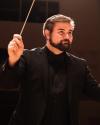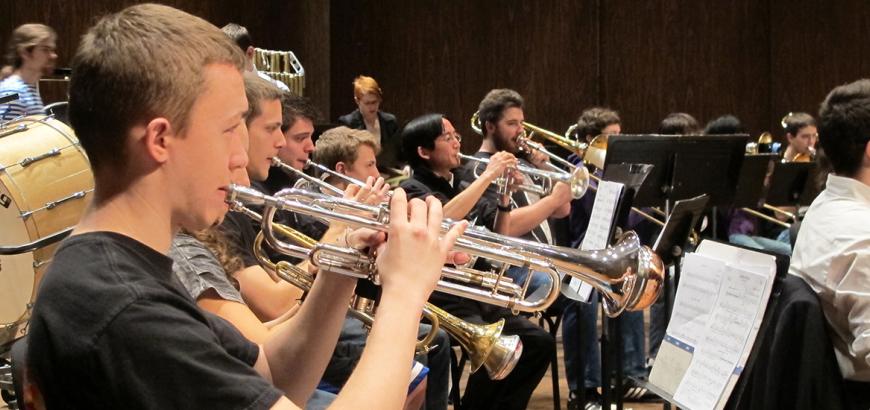The UW Concert and Campus Bands present their Spring Quarter concert. The Concert Band (Corey Jahlas, conductor) performs music by J. Clifton Williams, Chris Pilsner, and Hirotaka Izumi. The Campus Band (Roger Wu Fu, conductor) performs music by Vincent Persichetti and Alfred Reed.
Masks are recommended in all indoor spaces. Proof of vaccination remains a requirement for everyone 12 and over at Meany Hall and all ArtsUW Ticket Office events, including Meany Center, DXARTS, Dance Department, School of Drama, and School of Music. Individuals unable to be fully vaccinated, including people with a medical or religious exemption, must have proof of a negative provider-administered COVID-19 test (taken within 72 hours of the performance). UW staff will check for proof of vaccination and negative COVID tests at the doors as a condition of entry. Proof of negative test result must come from a test provider, a laboratory or a health care provider. Home or self-administered tests will not be accepted. Details of these policies and procedures are at: https://artsevents.washington.edu/covid-protocols
Program
University of Washington Concert Band
Corey Jahlas, conductor
The Sinfonians (1960): J. Clifton Williams (1923-1976)
Dum Spiro Spero (2010): Chris Pilsner (b.1986)
宝島 (Takarajima, “Treasure Island”) (1987): Hirotaka Izumi (1958-2021), arr. Toshio Mashima (1949-2016)
University of Washington Campus Band
Roger Wu Fu, conductor
Divertimento for Band, Op. 42 (1950), Vincent Persichetti (1915-1987)
I. Prologue
II. Song
III. Dance
IV. Burlesque
V. Soliloquy
Vi. March
Armenian Dances, Part One (1972/1974): Alfred Reed (1921-2005)
Program Notes
The Sinfonians was commissioned by the Phi Mu Alpha Sinfonia Fraternity of America in dedication to Archie N. Jones, a former president of the fraternity. The work marked the first in a long series of instrumental works commissioned by the fraternity. Clifton Williams, the work’s composer, was himself a member of Phi Mu Alpha, and conducted the premiere of the work at the fraternity’s national convention in 1960. Written as a symphonic march, The Sinfonians is a popular staple of the concert band repertoire, and its processional-like style makes it a popular piece to be performed at graduation ceremonies. The work opens with a strong series of fanfares, followed by the main theme presented in the horns and trombones. This theme is based on the fraternity song, “Hail Sinfonia!” which itself is based on a portion of the song Hail, Poetry from Gilbert and Sullivan’s “Pirates of Penzance”. The march includes an optional men’s chorus (not featured in this performance) singing a second fraternity song, “Men of Song,” which serves as the source material for the processional-like secondary theme.
About his piece, composer, Chris Pilsner, writes: “Dum Spiro Spero takes its title from a Latin phrase meaning “While I breathe, I hope.” When I read that phrase for the first time, I was taken back by the incredible amount of power it held and immediately knew it would be the basis for a new piece.
When I started writing, my goal was to write something as deeply emotional and human as the title was. The result was a series of simple melodies supported by some of the most colorful orchestration and harmonies I’ve ever written. From the lush opening, the gentle singing, and ultimately the triumphal climax, the human quality to the music is what I think gives Dum Spiro Spero a powerful sense of grace and splendor. It is dedicated to Casey Cropp, the man who has served as a mentor and friend for much of my musical career.
Dum Spiro Spero was commissioned by director Casey Cropp and the Rocky Mountain High School Winds Ensemble in 2009. The piece premiered on January 28th, 2010 at the Colorado Music Educators Association Conference in Colorado Springs, CO with the composer conducting."
Hirotaka Izumi (和泉宏隆) was a Tokyo-born keyboardist, pianist, and composer. Heavily influenced by American jazz pianist Bill Evans, Izumi joined the jazz-fusion band T-Square in 1982, where he performed as the band’s keyboardist, and would eventually be in charge of the bands’ arrangements. Izumi wrote Takarajima (“Treasure Island”) for the band in 1986, and it was arranged for wind band in 1987 by Japanese arranger Toshio Mashima. Takarajima was featured on the Japanese anime “Hibike! Euphonium” and became an iconic piece for Japanese wind bands. The piece is a samba (a departure from T-Square’s other jazz/funk repertoire selections) and features two saxophone solos and a robust percussion section.
Divertimento was premiered by The Goldman Band on June 16, 1950, with the composer conducting. The composition was begun during the summer of 1949 in El Dorado, Kansas. According to various sources, Vincent Persichetti began the work with a clash between choirs of woodwinds and brass and timpani "arguing" with both. Soon after scoring the opening, he realized that the strings were not going to become a part of this piece. In an article from 1981 Persichetti stated:
I soon realized the strings weren't going to enter, and my Divertimento began to take shape. Many people call this ensemble "band." I know that composers are often frightened away by the sound of the word "band", because of certain qualities long associated with this medium – rusty trumpets, consumptive flutes, wheezy oboes, disintegrating clarinets, fumbling yet amiable baton wavers, and gum-coated park benches! If you couple these conditions with transfigurations and disfigurations of works originally conceived for orchestra, you create a sound experience that's as nearly excruciating as a sick string quartet playing a dilettante's arrangement of a nineteenth-century piano sonata. When composers think of the band as a huge, supple ensemble of winds and percussion, the obnoxious fat will drain off, and creative ideas will flourish.
- Program Note by William V. Johnson for the San Luis Obispo Wind Orchestra concert program, March 19, 2011
Alfred Reed was born into a family of Austrian descent that cherished music, and his musical studies at age ten on trumpet. By high school he was performing professionally in the Catskills at resort hotels. He served as musician and arranger during World War II in the 529th Army Air Force Band, for which he created more than 100 works, and following the war was a student of Vittorio Giannini at Juilliard.
He was staff composer and arranger for both the National Broadcasting Corporation and the American Broadcasting Corporation. In 1953, Mr. Reed became conductor of the Baylor Symphony Orchestra at Baylor University in Waco, Texas, at the same time completing his academic work; he received his B.M. in 1955 and his M.M. in 1956. His Master's thesis was the Rhapsody for Viola and Orchestra, which later was to win the Luria Prize. It received its first performance in 1959 and was subsequently published in 1966. During his two years at Baylor, he also became interested in the problems of educational music at all levels, especially in the development of repertoire materials for school bands, orchestras, and choruses. This led, in 1955, to his accepting the post of editor at Hansen Publishing in New York.
With over 250 published works for concert band, wind ensemble, orchestra, chorus, and various smaller chamber music groups, many of which have been on the required performance lists in this country for the past 20 years, Mr. Reed is one of the nation’s most prolific and frequently performed composers.
Reed provides the following program note in the work’s score:
“Armenian Dances, Parts I and II, constitute a four-movement suite for concert band or wind ensemble based on authentic Armenian folk songs from the collected works of Gomidas Vartabed (1869-1935) [commonly known as Komitas], the founder of Armenian classical music.
Part I, containing the first movement of this suite (the remaining three movements constituting Part II), is an extended symphonic rhapsody built upon five different songs, freely treated and developed in terms of the modern integrated concert band or wind ensemble. While the composer has kept his treatment of the melodies within the general limits imposed on the music by its very nature, he has not hesitated to expand the melodic, harmonic, and rhythmic possibilities in keeping with the demands of a symphonic-instrumental, as opposed to an individual vocal or choral approach to its performance. Nevertheless, it is hoped that the overall effect of the music will be found to remain true in spirit to the work of this brilliant composer-musicologist, who almost single-handedly preserved and gave to the world a treasure trove of beautiful folk music that to this day has not yet become as widely known in the Western world as it so richly deserves. It is hoped that this new instrumental setting will prove to be at least a small step in this direction.”
University of Washington Concert Band
|
DIRECTOR BIOS

M.M Wind Conducting, Peabody Institute of the Johns Hopkins University, 2020
M.Ed. Education, Concordia University Irvine, 2018
B.A. Anthropology, University of California Los Angeles, 2014
Recent works include producing and music directing his original musical “Yappie: The Musical” and its concept album premiere, music directing chamber operas exploring the relationship between growth and suffering in Baltimore’s contemporary opera scene, and presenting research on instrument pedagogy, choice, and personality at Ohio State University. At the Peabody Institute of the Johns Hopkins University, Roger worked as a conductor, performer, teaching assistant and faculty substitute. Through summer conducting workshops, Roger has worked with conductors including Dr. Travis Cross, Dr. Mallory Thompson, Professor Charles Peltz, Dr. Cynthia Johnston Turner, Dr. Mark Scatterday, Professor Kevin McKeown and Dr. Mitchell Fennell. Drawing from his own varied background studying anthropology at the University of California, Los Angeles, and Wind Conducting at Peabody Institute of the Johns Hopkins University, Roger seeks to combine a high standard of musical performance with a rigorous academic approach, always seeking to explore and present music in a new and different light.
Outside of music, Roger works with the mental health foundation Healthy Gamer by providing peer-delivered recovery support services as a group and personal coach. In his offtime, Roger enjoys being a mediocre cook, catching up on popular shows from half a decade ago, and biking. Roger is extremely excited to join the Husky family at UW, and get to know the PNW at large - Go Dawgs!

Originally from Highland, MI, Corey Jahlas is in his first year of the Doctor of Musical Arts and Instrumental Conducting program at the University of Washington, where he serves as a Graduate Student Conductor of the Husky Athletic Bands, co-conductor of the Campus Band, and assistant conductor of the Wind Ensemble.
Most recently, Corey earned his Master of Music in Wind Conducting from Central Michigan University, studying with Prof. Jack Williamson. There, he instructed the 280-member Chippewa Marching Band and served as the instructor on record for the Symphony Band and the University Band. Prior to his Master’s work, Corey taught from 2014-2017 in Oxford, MI, leading the middle school band program, the OMS Percussion Ensemble, and assisting with the OHS Wildcat Marching Band.
Corey also holds degrees in Music Education and Music Theory and Composition from Central Michigan, where he studied euphonium with Dr. Mark Cox and composition with Dr. David Gillingham. Sharing his love for the marching arts, Corey served as Assistant Director of the Madison Scouts Drum and Bugle Corps in 2014, having marched with the group in 2011. He also serves as a clinician, arranger, and drill writer for high schools and university marching bands in Michigan, Ohio, Pennsylvania, and New Hampshire, and is the Director of the Drum Major Camp at Central Michigan University. Corey holds memberships in the National Association for Music Education, Pi Kappa Lambda, Phi Mu Alpha Sinfonia, and Kappa Kappa Psi.
